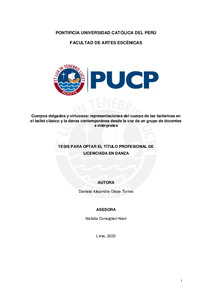| dc.contributor.advisor | Consiglieri Nieri, Natalia | |
| dc.contributor.author | Olaya Torres, Daniela Alejandra | |
| dc.date.accessioned | 2020-08-31T23:41:00Z | |
| dc.date.available | 2020-08-31T23:41:00Z | |
| dc.date.created | 2020 | |
| dc.date.issued | 2020-08-31 | |
| dc.identifier.uri | http://hdl.handle.net/20.500.12404/16902 | |
| dc.description.abstract | El ballet tiene una historia y una estética, y con estas, existe también una
concepción -a veces implícita y otras públicas- en torno a las capacidades
escénicas y al cuerpo que deben tener quienes lo interpretan. En este contexto,
se suele ver la delgadez de la bailarina como una característica positiva y
necesaria para bailar. Esta investigación parte de la premisa de que esta
percepción sobre el cuerpo de la bailarina de ballet influye en otros tipos de
danza, como la danza contemporánea. En consecuencia, a través de esta
investigación se busca retratar, a partir de la voz de docentes e intérpretes de
ballet clásico y danza contemporánea, aquellas prácticas y discursos en donde
se reproduce el mandato por un cuerpo delgado como el requerido y adecuado
para bailar. A modo de reflexión, se busca visibilizar el conflicto entre el
reconocimiento positivo de la diversidad anatómica, a través de la concepción en
la danza contemporánea de que “todo cuerpo baila”, y los discursos y prácticas
que intervienen en el disciplinamiento del cuerpo de la bailarina para que este
sea más delgado, que afecta incluso el bienestar integral de la intérprete. A nivel
metodológico se realizó una revisión bibliográfica sobre la historia del ballet y de
la danza contemporánea y se puso esta información en diálogo con fuentes
secundarias, provenientes de diversas disciplinas, acerca de los constructos de
género, el cuerpo, su disciplinamiento y el poder. Paralelo a ello, se realizaron
doce entrevistas a docentes y estudiantes de ballet clásico y danza
contemporánea, y se puso en diálogo dicha información con las experiencias de
la autora en tanto intérprete de ambos géneros (ballet clásico y danza
contemporánea). Al final del documento se comparten recomendaciones que son
producto de lo conversado con las entrevistadas. | es_ES |
| dc.description.abstract | Ballet has a history and an aesthetic, and with these there is also a conception -
sometimes implicit and others explicit- related to the body and the scenic
capacities that performers must have. In this context, the slimness of the dancer
is usually seen as a positive and necessary characteristic to dance. This research
comes from the premise that this perception of the body of ballet dancers
influences other types of dance, such as contemporary dance. Consequently, the
aim of this research is to portray, from the voices of classical ballet and
contemporary dance interpreters and teachers, those practices and discourses
where the mandate to have a slim body is reproduced like a required for dancing.
As final thoughts, it seeks to make visible the conflict between the positive
recognition of anatomical diversity, through the conception in contemporary
dance that "every body can dance", and the discourses and practices that
intervene in the discipline of the dancer’s body to make it slimmer, affecting even
the performer's overall well-being. At a methodological level, a bibliographic
review on the history of ballet and contemporary dance was made and this
information was put in dialogue with secondary sources from different disciplines
about gender constructs, body, and it’s discipline and power. Twelve interviews
were done with contemporary dance and classical ballet teachers and students;
this data collection was put in dialogue with the author's experiences as an
interpreter of both genres (classical ballet and contemporary dance). At the end
of the document, recommendations are shared as a product of what was
discussed with the interviewees. | es_ES |
| dc.language.iso | spa | es_ES |
| dc.publisher | Pontificia Universidad Católica del Perú | es_ES |
| dc.rights | info:eu-repo/semantics/openAccess | es_ES |
| dc.rights.uri | http://creativecommons.org/licenses/by/2.5/pe/ | * |
| dc.subject | Ballet | es_ES |
| dc.subject | Bailarinas de ballet | es_ES |
| dc.subject | Danza moderna | es_ES |
| dc.subject | Imagen corporal en mujeres | es_ES |
| dc.title | Cuerpos delgados y virtuosos: representaciones del cuerpo de las bailarinas en el ballet clásico y la danza contemporánea desde la voz de un grupo de docentes e intérpretes | es_ES |
| dc.type | info:eu-repo/semantics/bachelorThesis | es_ES |
| thesis.degree.name | Licenciado en Danza | es_ES |
| thesis.degree.level | Título Profesional | es_ES |
| thesis.degree.grantor | Pontificia Universidad Católica del Perú. Facultad de Artes Escénicas | es_ES |
| thesis.degree.discipline | Danza | es_ES |
| renati.advisor.orcid | https://orcid.org/0000-0002-0511-2904 | es_ES |
| renati.discipline | 215106 | es_ES |
| renati.level | https://purl.org/pe-repo/renati/level#tituloProfesional | es_ES |
| renati.type | http://purl.org/pe-repo/renati/type#tesis | es_ES |
| dc.publisher.country | PE | es_ES |
| dc.subject.ocde | https://purl.org/pe-repo/ocde/ford#6.04.04 | es_ES |






